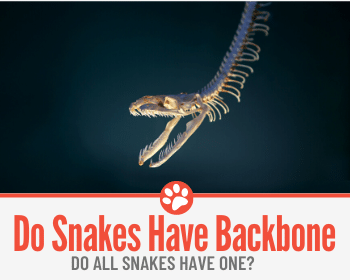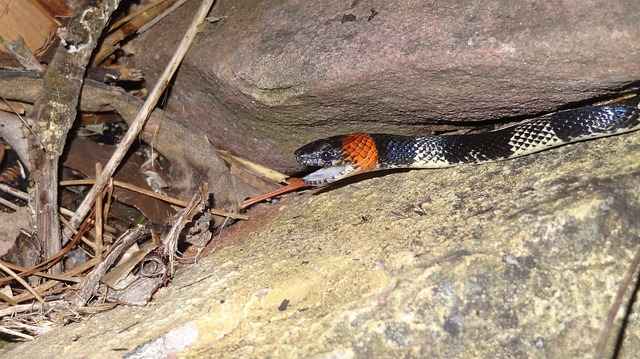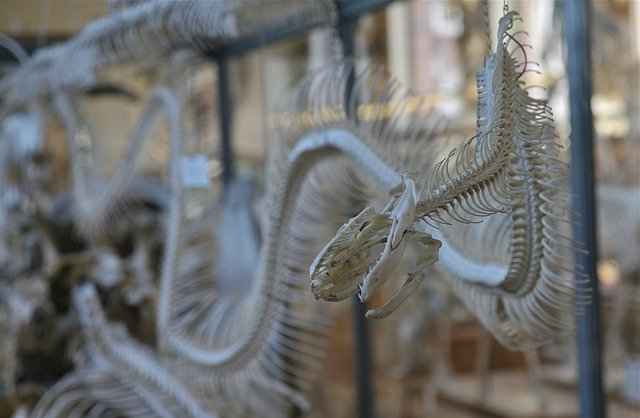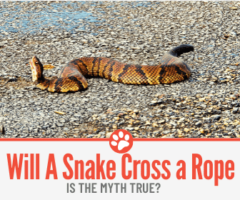 A slithering snake is an image that we are all very familiar with, a snake’s ability to glide through grasslands or traverse a river-bed is intriguing. This fascinating phenomenon led me to consider whether snakes do, in fact, have a backbone?
A slithering snake is an image that we are all very familiar with, a snake’s ability to glide through grasslands or traverse a river-bed is intriguing. This fascinating phenomenon led me to consider whether snakes do, in fact, have a backbone?
Snakes are found in nearly all corners of the world and even in the sea, the only places in the world that you will not find snakes are Antarctica, Iceland, Ireland, Greenland and New Zealand. Therefore, if you have Ophidiophobia (fear of snakes), then you know where to go!
Does a Snake Have a Backbone?
Snakes do have a backbone despite their flexibility. In the animal kingdom, one manner of categorising animals, can be to class them into vertebrates and invertebrates. Generally, the critical distinction between vertebrates and invertebrates is that vertebrates have a backbone (spine), whereas invertebrates do not. All snakes are vertebrates, and therefore all snakes have a backbone, the size of a snakes’ spine is dependent on the size of the snake.
Snakes’ long backbones (spines) are made up of many individual vertebrae. Snakes can have anywhere between one-hundred and four-hundred vertebra, dependent on their size and their means of killing their prey.
Snakes’ perfectly designed spines and jaws, which are discussed further in the remainder of this article, have allowed them to become some of the most feared predators in the world.
Do all snakes have bones and what about ribs?
Snakes have a simple bone structure this consists of a skull and a long backbone.
Snakes have a uniquely designed skull structure; the essential defining feature of a snakes’ skull is its agility. The skull has very few bones which are generally held by ligaments and muscles rather than bones and joints which would be typical of a human skull.
The majority of the snakes’ skeletal structure is made up of their backbone. Snakes can have anywhere between 200 and 400 vertebrae, to put this into context, humans only have approximately 33 vertebrae, even though we are generally larger than snakes.
Snakes usually have two types of vertebrae: precaudal (body) and caudal (tail). Snakes have a pair of ribs that are attached to each vertebra located in the body, with the exception of the few vertebrae that are located behind the head. The vertebra found in the tail, do not have ribs attached to them.
There are five points at which each vertebra interacts with other bones in order to create a joint: each vertebra is attached to the central spinal column with a ball-and-socket joint, then two protrusions from the vertebra (the prezygapophyses and the postzygapophyses) are used to attach the vertebra to the neighbouring vertebra, one protrusion is located at the top and the other at the bottom, these lock each vertebra in place.
Lastly, the zygosphene and the zygantra, create another ball and socket joint, which provides snakes with the ability to rotate their spines and enables snakes to move in their highly unique manner. This mechanism is almost exclusively found in the spines of snakes.
The structure of the spine provides stability, from the fact that each vertebra is attached to its neighbour.
This formation also provides flexibility, as the vertebrae can rotate but do not twist. This strong but malleable spine, allows snakes to easily contort, meaning that they are easily able to slither and wrap around prey without causing injury or damage to the spine.
Do snakes have jawbones?
Snakes have extremely flexible jaws which can expand to swallow large prey, occasionally bigger than their head; this flexibility is a product of a series of tendons, ligaments and muscles.
Despite the common misconception, snakes’ jaws do not dislocate; they remain attached despite the width that the mouth can open.
Snakes can open their mouths to such enormous widths due to specific features; firstly, snakes have an extra bone at the top of their skull rather than just two hinge joints at the side of their jaws, like humans.
Secondly, they have a separated lower jaw, which is not attached by bone but is instead attached by elastic ligaments. To eat large prey, the snake will walk the left and right side of the jaw along the body of the prey. Lastly, the upper jaw is made up of six bones which, in most snakes, can move forwards, backwards and sideways.

Does a Coral snake have a backbone?
Coral snakes can be divided into over 90 different sub-species of snakes; they are small, venomous and brightly coloured. Coral snakes are categorised into two broad groups, Old World Coral snakes and New World Coral snakes. Coral snakes are elapid snakes.
Elapid snakes are a venomous species of snake that can be identified by short fangs, fixed in the upper jaw.
Elapid snakes generally strike with a downward stab which is used to stun the prey, and they subsequently follow this with chewing. Since elapids use this chewing motion to kill their prey, their bites are generally not likely to be fatal to humans or other large prey.
The coral snake’s spine has evolved explicitly to allow the snake to kill its prey efficiently and effectively.
As Coral snakes use venom-delivery as their primary means of killing their prey and they generally inhabit pine and oak scrub habitats, they need to be able to move, silently and efficiently through the vegetation to limit the risk of drawing attention to their presence and providing their prey with the opportunity to escape.
Does a Kingsnake have a backbone?
There are seven different species of Kingsnake which can be found anywhere from south-eastern Canada to Ecuador.
Kingsnakes have gained their name because they are occasionally cannibalistic and eat other snakes.
Kingsnakes are nonvenomous snakes that constrict their prey rather than injecting them with venom. Kingsnakes concertina their spine, to shorten and lengthen their bodies, and this allows them to draw in their prey.
Once the constrictor has hold of the prey, they can then bend and curl to tightly grip it, restrict the blood flow to its vital organs or overload their internal systems causing haemorrhaging and eventual death.
Kingsnakes eat a varied diet of small mammals, lizards, amphibians, bird eggs and as mentioned above, occasionally other snakes.
Once swallowed, all snakes then use the muscles in the oesophagus to push the food down toward the stomach, the snake then moves the spine to accommodate the food and uses their exceptionally flexible ribs to push on the food and move it food further down the throat into its stomach.
How have snakes evolved to be excellent at catching their prey?
Snakes don’t have eyelids; instead, they have a transparent membrane covering their cornea. This membrane acts like a protective layer that refracts light, and it also regenerates if it becomes damaged at any point.
Dependent on the time of the day at which snakes hunt, their eyes will either allow UV light in (night-time hunters) or block UV light (day-time hunters). Snakes have a diverse set of rods and cones, which will enable them to see certain visual pigments.
Visual pigments in the eye allow animals to see in colour. Snakes’ visual pigments have changed to make them excellent at living in low light conditions on land. Snakes do generally only see two visual pigments, rather than three, for example in humans.
Therefore, snakes’ eyesight is generally considered “poor” despite the many advanced features of their eyes.
Snakes’ ears are located inside their heads by their jawbones. Snakes “hear” therefore by sensing vibrations through their skulls. Snakes hearing is consequently considered weak, and snakes rely much more on their sense of smell to hunt their prey.
Due to poor eyesight and hearing, snakes use their tongues to sense their surroundings. Even though snakes do have nostrils, they generally use their tongues to smell their surroundings, including identifying if any prey or predators are in the vicinity.
Snakes have forked tongues which are designed so that they can detect the smells around them three-dimensionally, snakes are able to do this because they are able to split their tongue twice as wide as their heads, this then means that they are able to collect data from two separate locations, at the same time.
This data collection process allows snakes to identify, for example, that prey may be closer to their left-hand side rather than the right.
In order to smell, the tongue is flicked into the air, to gather minuscule moisture particles when the snake then brings the tongue back into its mouth, it goes to the roof of the mouth and into the Jacobson’s organ. The Jacobson’s organ is an area of sensory cells that detects odour in moisture particles.
Snakes can, therefore, identify what their potential prey is and where it is located, allowing them to use their energy efficiently and have a strong chance of making a successful hunt.

Why have snakes evolved to be legless?
A snake slithering is a familiar image. Snakes have evolved to be legless, the reason that snakes no longer have legs is that a trio of mutations occurred. In the past snakes used to have legs but they were still able to slither.
There has been recent evidence to show that certain snakes appeared to have “re-evolved” to grow legs. In reality, snakes have not re-evolved, but instead, as scientists discovered, snakes continued to possess the gene to be able to grow limbs.
This gene is named the “Sonic hedgehog”; the reason for this name is a reference to the hedgehog-like spines that grow from embryos in limb development. Snakes, therefore, have the capacity to grow legs and there are certain species who possess limbs.
Are snake numbers declining, and what does this mean for the future of particular ecosystems?
Snake numbers are declining, according to scientists at an “alarming rate”. While there is no concrete proof to determine the specific reasons for the declining population, scientists suspect that this is because of a decline in both prey numbers and the viability of habitats.
The degradation of habitats is mainly due to climate change and environmentally damaging activities such as deforestation, urban development, and agriculture.
Snakes are critical to both ecosystems and local communities for two key reasons: firstly, snakes are either the top-order or middle-order predator in most ecosystems, and therefore they play an essential role in controlling prey numbers.
Furthermore, in ecosystems in which snakes are a middle-order predator, other predators may decline because the availability of snakes as prey is limited.
Therefore, the impact on the ecosystem is exacerbated. An overpopulation of prey can lead to natural habitats becoming damaged.
Secondly, if there is an over-population of prey, this can lead to rodent problems for local human communities. Rodents can impact communities’ ability to harvest crops successfully and can infect water supplies which can result in infection and malnourishment in human populations.






